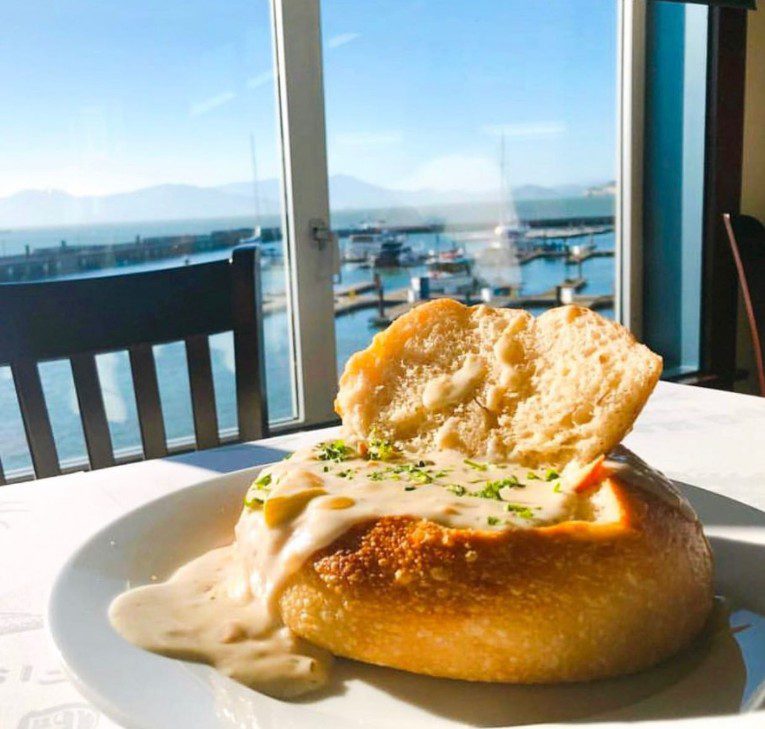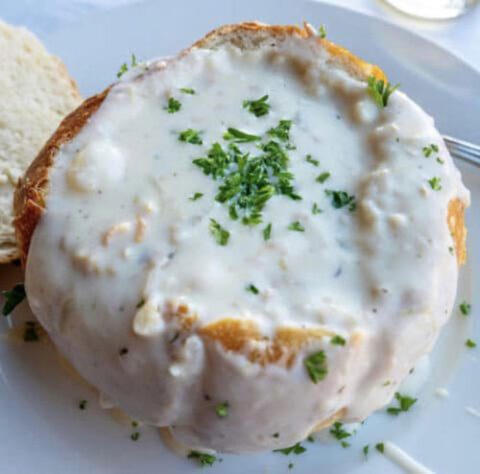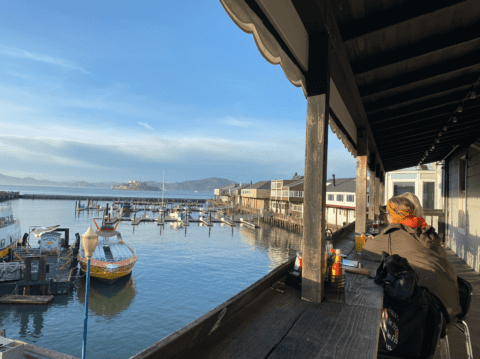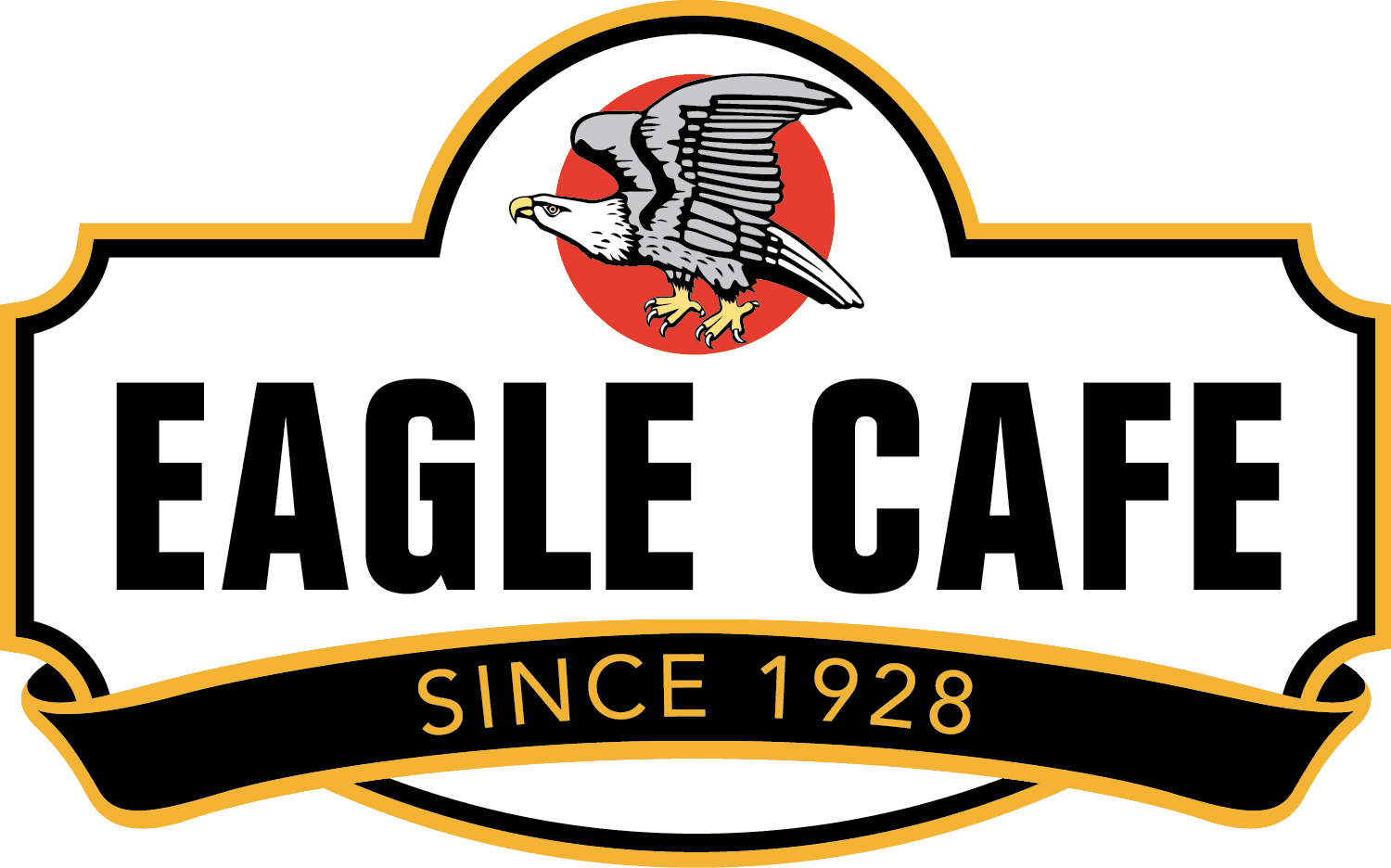
- Clam chowder’s origin stretches back to 16th-century Europe
- While many versions exist, the most beloved varieties include tomato-based Manhattan and creamy New England
- Eagle Cafe is the perfect Pier 39 spot to get a taste of clam chowder history and experience San Francisco’s spin on this favorite
There’s something so comforting about a bowl of soup, especially on a chilly day. If you’re visiting San Francisco’s historic Fisherman’s Wharf and Pier 39, clam chowder is a surefire way to warm your heart and your tummy in any kind of weather.
But have you ever wondered about clam chowder’s origin? What is the history of clam chowder? How has it changed? And where can you go to enjoy the best modern takes on this classic soup? Here’s everything you need to know about this delicious dish and the best way to enjoy it on Pier 39.
What Is Clam Chowder?
Exploring the history of clam chowder starts with knowing what it is. Basically, it’s any soup that has broth and clams, and most often it’s thick. The term “chowder” is thought to come from either the Latin (calderia) or French (chaudiere), both meaning “cooking pot,” although some scholars suspect it derived from the English word jowter, meaning “fish peddler.”
Typical Ingredients
Throughout the history of clam chowder, the ingredients have evolved, but today’s most common versions include clams, clam juice, cream, roux (a mixture of butter and flour), potatoes, and a variety of other ingredients.
Types of Clams Used in Chowder
At the time of clam chowder’s origin, the clams would have likely been fresh-caught. Nowadays, canned clams are often used for convenience. Either way, the clams included in chowder are typically the slow-growing type and have a diversity of sizes. Clam choices tend to be littlenecks, cherrystones, or quahogs. The latter is most common, as they’re pretty meaty, but cherrystones, though smaller, are also popular.
The Clam Chowder Origin Story
So, when did this dish first appear on the dining scene? Although a modern favorite at Pier 39, clam chowder has a history that dates back hundreds of years.
Early History
The first mentions of chowder trace back to the 16th and 17th centuries in northwestern France and southwestern England. Various recipes began appearing in published works in the mid-1700s.
Original recipes had a very thin broth, and seafood chowders were made with any available option, not just clams. However, one anecdote in the history of clam chowder mentions shipwrecked French soldiers in coastal Maine putting seafood and pork into a creamy stew and loving the flavor.
The Move West
Before becoming a Pier 39 staple, clam chowder in the New England style gained popularity in the northeastern U.S. It appeared on the menu of Boston’s historic Ye Olde Union Oyster House in 1836 and made its way west thanks to New Englanders pursuing California’s gold rush.
With the Bay Area’s abundance of fresh clams and other seafood, dishes like clam chowder quickly became popular favorites. Over 175 years later, this soup is a must-have San Francisco treat found on menus across the city, adding to the rich history of clam chowder even in modern times.
Varieties of Clam Chowder
No look at the history of clam chowder would be complete without talking about its variations. Probably the two most well-known versions are white New England and red Manhattan.
New England Style
The most popular option on Pier 39, clam chowder in the New England style, is thick and made with clams, onions, pork, potatoes, and cream. It usually doesn’t have other vegetables, and the cream gives the soup its signature white color.
Manhattan Style
This version of clam chowder has a reddish color thanks to tomato paste and fresh tomatoes. It’s most often thinner and includes more vegetables like carrots and celery.
Other varieties you might find include ones from New Jersey, Rhode Island, Hatteras/North Carolina, and Mexico. There’s even a spicy Minorcan clam chowder hailing from Florida. The history of clam chowder has led it to places far and wide.
What’s Special About San Francisco Clam Chowder?

With its rich flavors and the natural warming qualities of soup, clam chowder is prized as a cold-weather comfort food. Although the history of clam chowder is long and varied, it’s no surprise that it’s popular in a city known to be brisk year-round. But even on warm days in San Francisco, you’ll find Pier 39 diners enjoying clam chowder at a favorite eatery.
While consuming clams and other mollusks comes with health benefits—they’re rich in vitamin B12, iron, and zinc to boost immunity and ward off fatigue—it’s more likely the delicious flavor that keeps clam chowder at the forefront of San Francisco dining. It’s also probably the city’s unique sourdough spin on the dish that puts it at the top of visitors’ must-eat lists.
San Francisco’s sourdough is often considered the best in the world, and when the gold miners began pairing it with clam chowder, it was a match made in heaven. To this day, Bay Area restaurants almost always serve the soup with a side of sourdough, or, more iconically, in a bowl made of the bread. It’s fun to look at and to eat, and the flavors of both components create a tasty, comforting clam chowder experience that’s second to none.
Where To Get Great Clam Chowder on Pier 39
Now that we’ve tempted your tastebuds with this exploration of clam chowder and its origin, it’s time for you to sit down to a hearty bowl and add your own personal experience to the history of clam chowder. What better way to do that than while enjoying epic views of the bay where some of the soup’s ingredients were harvested?
You can enjoy clam chowder on Pier 39 at any number of great spots, including Pier Market, Fog Harbor Fish House, and Crab House at Pier 39. But for an authentic combination of clam chowder history and a historical dining spot, there’s no better option than Eagle Cafe.
Join Us Today at Eagle Cafe

First opening our doors nearly a century ago, Eagle Cafe is as much a part of local lore as the history of clam chowder itself. Serving up breakfast and lunch specialties 365 days a year, we offer family-friendly dining in a casual setting. Pairing classic dishes with stunning views from our forward-facing outdoor patio is the perfect way to reflect on the rich origin of clam chowder in one of its most epic settings.
Whether you’re a local craving a bowl to warm you up or a visitor exploring the history of clam chowder and the city itself, a stop at Eagle Cafe on Pier 39 for clam chowder is a must. Join us and enjoy a bowl today!
